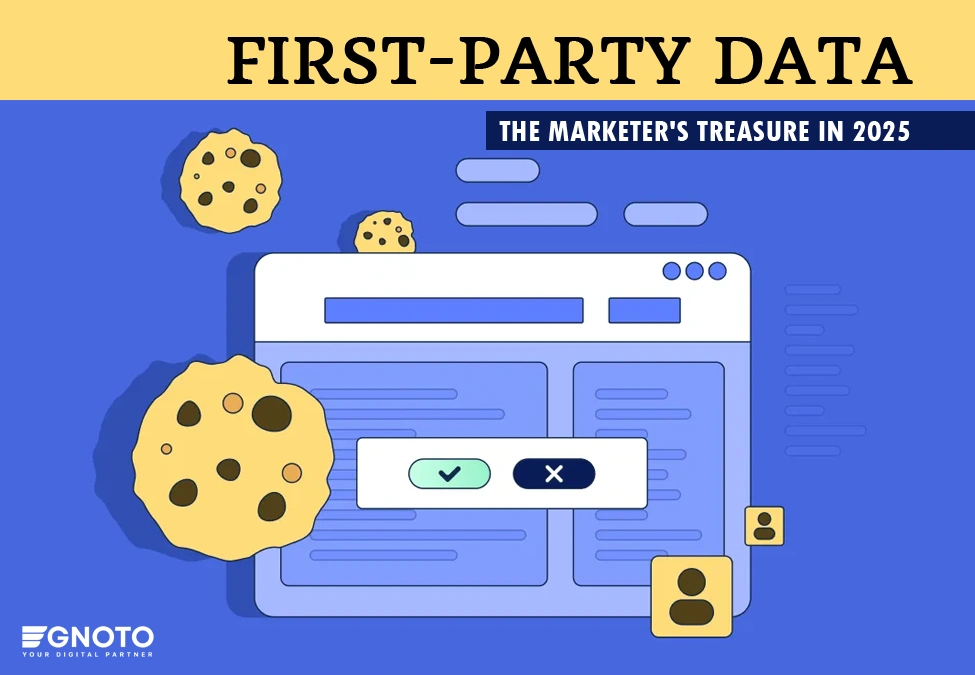Have you ever thought why you are not getting results when you are also retargeting like your competitors? It might have happened because you used incorrect or outdated data about your audience. Well, everyone says data has become the new gold because it helps you target the right audience at the right time. However, not all data is useful and reliable.
Marketers need first-party data that comes directly from their audience, not with the help of an agency or a partner. When it is not first-party data, it might not provide you with the correct results or desired outputs. Apart from that, the decline of third-party cookies and the rise of privacy regulations have compelled marketers to seek new ways of data collection.
Since first-party data is collected directly from customers, it has become a vital asset for marketers in the present time. The rising competition also requires marketers to use the best and fastest ways to target and retarget the right potential customers, and this type of data helps in the same. Go deeper into this marketing strategy with us and explore new and best opportunities to take your business to the next level.
What Is First-party Data and How Is It Different from Others?
First-party data refers to information that a company itself collects directly from its customers. There is no mediator or agency involved to get this work done for your company. You yourself create questions for the survey and conduct it without involving a third party.
What information does first-party data collect?
- Website interactions: Pages visited, time spent, and navigation paths.
- Purchase history: Products bought, frequency, and value.
- Customer feedback: Surveys, reviews, and support interactions.
- Email engagement: Open rates, click-throughs, and preferences.
This data is obtained with the customer’s consent, making it both ethical and reliable.
First-party, Second-party, Third-party Data: Is There a Difference?
Yes, there is. Do not get confused while seeing these terms. Let’s distinguish between them in the space below.
- First-party data is information a company collects directly from its customers. For example, website activity, purchase history, and more.
- Second-party data is someone else’s first-party data that you access. For example, a travel agency shares customer preferences with an airline.
- Third-party data is collected by data merchants. They don’t have a direct relationship with the user or website.
The Importance of First-Party Data in 2025
Ever since restrictions have grown on third-party cookies and an increasing focus on user consent, marketers have had to shift to first-party data. It’s a more reliable and accurate way of targeting customers. That’s why, in 2025, marketers prefer first-party data for accuracy and privacy compliance. So, let’s go deeper to understand the significance of this type of data in the space below.
1. The Demise of Third-Party Cookies
Due to privacy reasons, most browsers have phased out third-party cookies. They have limited tracking of users across the web to protect sensitive information. It has led to a change in data collection strategies. Now, companies use first-party data to understand customer behavior and personalize experiences. First-party data is mostly considered safe for companies and their customers.
2. Enhancing Personalization
Personalization has become the new normal in the current scenario of digital marketing. It helps to attract more customers and convert them into loyal customers. Since you have all the crucial details about the customer’s demographics, it helps to tailor emails effectively. You can analyze customers’ preferences and behaviors and target them with a specific goal. This accurate targeting will increase engagement and conversions.
3. Improving Marketing Efficiency
Since first-party data helps to enable more accurate targeting, your marketing team would not have to put in extra effort. Otherwise, the team ends up spending most of its time on data cleaning, removing redundancy, and making it capable of being analyzed. Now, they can skip this part because the data is collected by their team itself. It saves resources that marketers can use to focus on high-intent audiences and ensure a better return on investment.
Strategies for Collecting First-Party Data
There is one more reason why first-party data is considered more reliable: The way it is collected. How you collect data also ensures whether your strategies will work or not. Here are some effective ways for marketers to collect first-party data.
1. Interactive Content
Interactive and relevant content automatically attracts users. Quizzes, surveys, and polls are examples of such content. They engage users quickly and provide valuable insights. You can also conduct a random interview with people walking on the street and ask them about the brand and its services. But do not ask them about the brand directly; frame the question in a way that doesn’t sound salesy. For example, a skincare brand might use a quiz to recommend products based on skin type. Before that, it collects data on customer preferences for better targeting and services.
2. Loyalty Programs
Nothing can be better than when a customer shares his information with you without asking. Loyalty programs help in achieving it. Reward customers for repeat purchases and encourage them for better benefits in the future. They will share the details to get more benefits. Loyalty programs can track buying habits and preferences to offer personalized rewards and promotions.
3. Email Subscriptions
Explain to potential users how beneficial it is to subscribe to your newsletter. After seeing a value, they will be more likely to subscribe to your newsletter. But where will you show them that it is worthwhile to subscribe? Invite them on different platforms and encourage interaction. This way, you can get more subscribers and obviously more data. It will help you segment the email list for more effective communication.
4. Account Registrations
Account registration is also an effective way to collect first-party data. Prompt users to create an account to access more detailed information. This way, you can get their names, email IDs, age groups, and more. Most companies use this tactic to get customers’ information so they can target them more precisely.
How to Use First-Party Data for Success in 2025?
You have collected the data and know the strategies, but it makes no sense until you know how to use the first-party data. Here are some well-curated steps to use first-party data from the experts at Egnoto.
Let’s understand it with an example:
Suppose GreenNest (An imaginary company) is an eco-friendly home products brand. It sells reusable kitchen items through its website and mobile app.
They collect first-party data from:
- Website visits
- Email signups
- Purchase history
- Customer feedback
- App behavior
Now, understand how GreenNest can use this data for marketing success:
Step-1: Segment the Audience
It will segment the audience based on the information below.
- Frequent buyers
- One-time shoppers
- Customers who only browse eco-cleaners
- People who abandoned their carts
This way, you can send the right message to the right person. For example, cart abandoners get a reminder plus a discount, while loyal buyers get a thank-you coupon.
Step-2: Personalize Email Campaigns
Now start your personalized email campaign. For this, use the customer’s name, purchase history, and browsing history. GreenNest creates tailored email flows using these details. Some examples are as follows:
“Hi Sam, your favorite bamboo mat is back in stock!”
“You bought reusable wipes, check out our new compost bin!”
These personalized messages can work more effectively because personalized emails get 2x–3x higher open rates and conversions.
Step-3: Improve Product Recommendations
Now, it’s time to improve product recommendations. For this, the company uses browsing and past purchase data to suggest similar products. If someone buys a bamboo toothbrush, they will recommend bamboo holders or natural toothpaste. This is because customers are more likely to buy add-ons or related products when they feel understood.
Step-4: Optimize Ad Retargeting
GreenNest gets the most out of its marketing efforts using both organic and paid marketing. The company shows retargeting ads only to people who viewed a product but didn’t buy. They can track without violating privacy laws, using first-party cookies and pixels.
Final Thought
First-party data has become more important than ever. And, as technology evolves, its role will also become more important. Since AI is touching every aspect of marketing, it will also not remain an exception. Integrating artificial intelligence and machine learning can further enhance data analysis. For now, enjoy the benefits offered by first-party data. Understand its significance and data collection strategies, and implement them per your business model and goals. Personalize customer messages and increase the chances of better ROI this year.










